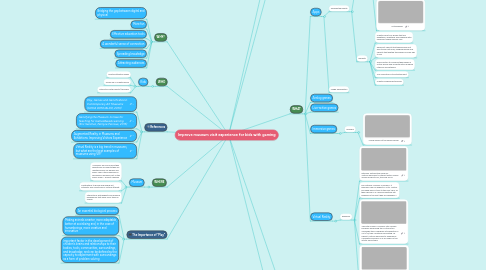
1. WHY?
1.1. Bridging the gap between digital and physical
1.2. More fun
1.3. Effective education tools
1.4. A wonderful sense of connection
1.5. Spreading knowledge
1.6. Attracting audiences
2. WHO
2.1. Kids
2.1.1. Shorter attention spans
2.1.2. Grown up in a digital world
2.1.3. Interaction with parents/ teachers
3. References
3.1. Play, Games and Gamificationin Contemporary Art Museums (SOFIA ROMUALDO, 2013)
3.2. Gamifying the Museum: A Case for Teaching for GamesBased Learning (Eric Sanchez, Palmyre Pierroux, 2015)
3.3. Augmented Reality in Museums and Exhibitions: Improving Visitors Experience
3.4. Virtual Reality is a big trend in museums, but what are the best examples of museums using VR?
4. WHERE
4.1. Museum
4.1.1. “Museums are much more than repositories of objects.they are meeting places for people and ideas. Their future depends on remaining a dynamic part of the public realm."- Robert Hewison
4.1.2. Destinations to house and display art, artefacts and collections of cultural interest.
4.1.3. Interactions with exhibits and learning experiences that differ from those in school.
5. The Importance of "Play"
5.1. An essential biological process
5.2. Making animals smarter, more adaptable, better at socializing and, in the case of humanbeings, more creative and innovative
5.3. Important factor in the development of children's brains and relationships to their bodies, tools, communities, surroundings, and knowledge, and can be defined as the capacity to experiment with surroundings as a form of problem solving
6. Challenges
6.1. Keeping a steady stream of visitors
6.1.1. Applying new concepts and methods to helping audiences derive satisfaction and education from museum offerings
6.2. dynamism
7. HOW
7.1. Be very clear about who the audience for the games are and develop for that audience
7.2. Be thoughtful, work with agencies who understand how to make good games, make the games widely available, put them on gaming portals and not just on your museum’s website
7.3. Keep the ideas simple with great gameplay
8. WHAT
8.1. Apps
8.1.1. Augmented Reality
8.1.1.1. Examples
8.1.1.1.1. Kspace at the National Museum of Australia
8.1.1.1.2. Skin and Bones app at the Smithsonian National Museum of Natural History
8.1.1.1.3. Virtualidades
8.1.1.2. Benefits
8.1.1.2.1. Create visual tour guides that are adaptable, updatable and viewable with everyday mobile devices only
8.1.1.2.2. Resurrect objects that people were not able to see until now, bringing people and objects that existed thousands of years ago to life.
8.1.1.2.3. Allow visitors to immerse themselves in virtual worlds and recreate entire building interiors and exteriors.
8.1.1.2.4. Turn education into entertainment
8.1.1.2.5. Create compelling storylines
8.1.2. Image Recognition
8.2. Analog games
8.3. Live-action games
8.4. Immersive games
8.4.1. Example
8.4.1.1. “Inside Opera” at the Palais Garnier
8.5. Virtual Reality
8.5.1. Examples
8.5.1.1. Peterson Automotive Museum : Visitors were able to interact with a classic American sports car, the Ford GT40
8.5.1.2. The National Museum of Finland : It opened a new VR exhibit in 2018. Visitors can head back in time to the year 1863, as they explore R. W. Ekman’s painting The Opening of the Diet 1863 by Alexander II
8.5.1.3. The Tate Modern: London’s Tate Modern has been embracing the VR trend too. Alongside their Modigliani retrospective in 2017/18, they created a fascinating VR exhibit. Visitors were able to experience complete immersion in a 3D model of the artist’s Paris studio
8.5.1.4. The National Museum of Natural History in Paris :The National Museum of Natural History opened its first permanent VR exhibition in 2018. The installation deals with evolution, as part of the wider scope of the museum
9. WHEN
9.1. Field trip
9.2. Family time
9.3. Weekend
9.4. Summer vacation
10. Results
10.1. Entertainment Experiences
10.1.1. Making visitors stay longer
10.1.2. Making kids visit enjoyable and fun
10.1.3. Improving guided tours and labels
10.1.4. Creating tweetable information labels and allow photography
10.2. Education Experiences
10.2.1. Experiences where people want to learn
10.2.2. Inspiring kids to dig up more information
10.3. Escapist Experiences
10.3.1. Transporting kids into a different time and era
10.4. Esthetic Experiences
10.4.1. Interior-based experiences made more exciting
10.4.2. Engaging the visitors’ imagination
10.4.3. Free-flowing spaces with adequate natural lighting
